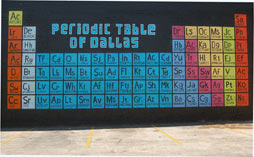By Sara Pintilie/entertainment editor
(Part one in a four-part series on the rebirth of the blues.)

Deep Ellum might not be the place for an up-and-coming blues musician to get his break these days, but the historic neighborhood was once the place for blues in DFW.
The Dallas Historical Society cites Deep Ellum as one of the hottest cities in the South during the 1920s-’30s.
“Deep Ellum became the place to hear the great blues and jazz musicians of the time,” Dallas Historical Society states on its Web site, www.dallashistory.org. “In Deep Ellum, there were more blues singers than just about anywhere else.”
Notable blues artists were Huddie “Leadbelly” Ledbetter, Bobbie Cadillac, Lillian Glinn, Dennis “Little Hat” Jones and Blind Lemon Jefferson.
“The Deep Ellum that they played in doesn’t even exit anymore,” Allison Welsh, a member of the Deep Ellum Association, said. “It was torn down to make room for I-75.”
The WPA Dallas Guide and History cites the original Deep Ellum as the area between Central Avenue, where the Houston and Texas Central track used to run, and Hawkins Street to the east of the 2500 block.
“What you have today that you think of as Deep Ellum was completely birthed separately from the blues,” Welsh said.

After Houston and Texas Central Railroad was removed to make room for the Central Expressway, the music scene started to shift from blues to other genres of music, such as punk rock, grunge rock and even pop.
“The blues is not the main history [of Deep Ellum] since the ’80s,” Welsh said. “It kinda died out whenever they tore down the tracks and during the war and definitely in the ’60s when they built the overpass.”
The music scene in Deep Ellum has changed dramatically since the blues. In recent years, the neighborhood switched its main focus from music.
“Right now, Deep Ellum isn’t about music. It is about art,” Welsh said.
But this neighborhood is still a unique destination.
“I like the plethora of music that surrounds the streets,” Terri Doty, a NE student, said. “There is a little something for just about everyone, i.e. Double Wide, Curtain Club, etc.”
Doty also likes the locally owned shops.
“There’s something about getting to go to a place that you can’t go anywhere else; chain restaurants are minimal there. Cafe Brazil is a must,” she said.
Nevertheless, with the amount of violence and crime reported from the area, people are wary of going to Deep Ellum.

“In the past two years, Deep Ellum hasn’t gone one month without someone getting stabbed, raped or murdered in that area,” Doty said. “Though I see the police in full force blocking the streets, they are nowhere near where they should be more than 70 percent of the time.”
Deep Ellum, despite its problems, still plays a part in Dallas culture.
“It’s the only part of Dallas that is not plastic,” Welsh said.
